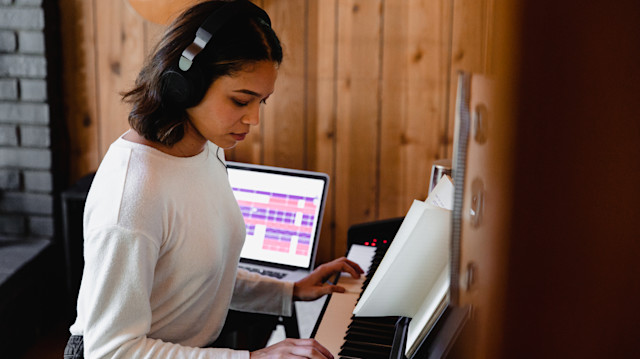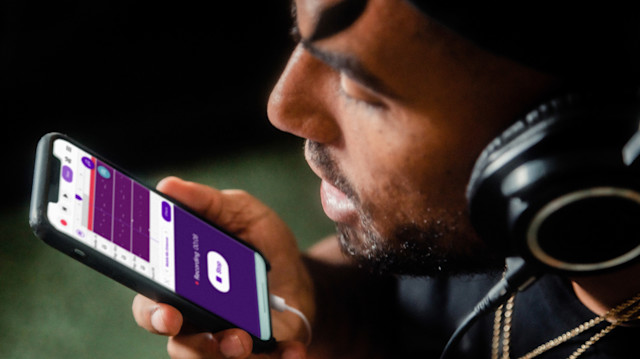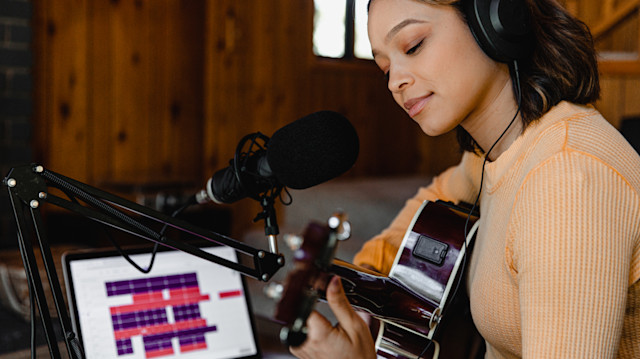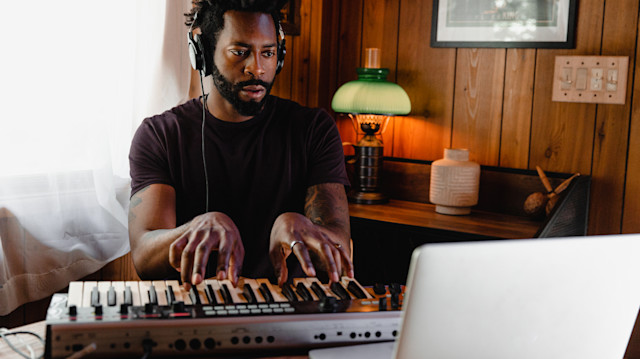Songwriting Tips: How To Write Incredible Songs
Learn how to write a song with tips and tools from Soundtrap's in-house pros. In this article, we cover how to write chord progressions, melodies, and lyrics, and show you how to become a skilled songwriter in any genre.

Songwriting is the heart of music-making. It’s where the music creation process starts and ends, and is the most important factor in whether a song becomes a hit or flop. It’s also one of the most powerful art forms with the ability to express feelings, tell stories, influence politics, and connect people from around the world.
For beginners and seasoned pros alike, the songwriting process is a fulfilling and challenging task. Not only does it require creativity and inspiration, but you must also master the right songwriting tools and techniques to bring a song to life.
Whether you’re into writing rap songs, pop, country, or EDM, this blog post will guide you through the songwriting process, and provide tips and tactics for creating music that resonates with listeners.
What is songwriting?
Songwriting is the art of creating music through chord progressions, melodies, and lyrics. It also involves coming up with ideas for songs and working out a song structure, like how many verses to write, when should the chorus come in, etc.
If you want to become a great songwriter, you need to find sources of inspiration, such as real-life events, strong emotions, or abstract concepts. Great songs resonate with the audience because the listener can relate to them. Your goal should be to come up with songwriting ideas that engage, move, and inspire listeners, and be vulnerable, personal, and universal at the same time.
Songwriting in different genres
There isn’t a one-size-fits-all when it comes to songwriting. Depending on the genre and function of music-making, the methods will differ. Having said that, the basics still apply: You need a strong song idea, a moving melody, engaging lyrics, and a solid song structure. We’ve listed a few examples of songwriting and how they can differ depending on the genre.
Pop songwriting: Pop songs are designed to be catchy and easy to listen to. They attempt to draw the audience in with a standard song structure and a strong hook that’s easy to sing along to. Pop songs typically use simple chord progressions and cater to a broad audience.
Rock songwriting: Rock songs are often characterized by high energy, complex drum beats, and the use of electric guitars. Classic rock songs are usually personal and emotionally charged, covering topics such as love, rebellion, and social issues.
Hip-Hop & Rap songwriting: Hip-hop songs originally used spoken word poetry set to a beat. Today, blending singing and rapping is more common in mainstream Hip Hop. The lyrics are longer, typically divided into verses of 16 bars, and deal with issues such as social justice and inequality. Rags to riches, materialism, and drug use are also common topics in some sub-genres of Hip Hop.
Electronic music songwriting: Electronic music focuses more on beats and sounds than lyrical content. It includes a wide range of styles, from House music and Experimental to Trance and Techno. Common instruments in Electronic songs are synthesizers and drum machines to create unique and innovative sounds.
Watch songwriter AmaZane write an RnB break-up song in Soundtrap.
Songwriting professions
Not only does songwriting vary depending on genres. Working as a songwriter can look very different depending on the individual. Here are some examples of popular songwriting professions:
Artist songwriter - Many performing artists also write their own songs. This is a great way to have more creative control and also earn more royalties from both the recording and the publishing rights.
Writing for other artists - Probably the most common songwriting profession. It’s very common in pop music to have separate songwriters and artists on a song.
Film, TV, and commercials - Another popular job for songwriters is to write music for film and television. Considering how many TV shows and movies are produced these days, this profession can be a very lucrative business for songwriters.
Publishing - A songwriter working for a music publisher is like an artist working for a record label. Your job is to create songs that the publisher then licenses to record companies, TV & film, commercials, etc. This is a great way of getting your music in front of big artists and important industry players.
Tips on how to write a song in 10 Steps
Every songwriting journey is different, but these steps will give you a good insight into the different stages of writing a song.
1. Come up with a song idea
Every song starts with an idea and songwriting inspiration can really come from anywhere. A great way to come up with a topic for your song is to dig deep into yourself. What are some strong emotions that you have at the moment? Can you recall some memories that have affected your life? Any lost loves or old friendships that have impacted you? What is going on in the world?
Some of the best songs ever written are commentaries on social issues and the current zeitgeist. How you come up with a song idea is really individual and you need to figure out what works best for you.
Using songwriting prompts
A songwriting prompt is a great starting point that can help generate ideas. Some examples of songwriting prompts include picking an emotion or feeling, a location, a strong memory, or even a random word or phrase.
Start with any of these prompts and let your creativity flow. See where it takes you. Not every idea is going to be a hit song but using these songwriting techniques will give you good practice for becoming a better songwriter over time.
Soundtrap’s Studio App
Songwriting ideas usually come when you’re on the go. That’s why it’s super useful to have a music-making app on your phone. Soundtrap’s Studio App lets you create music on the go, recording song ideas directly on your phone.
So the next time you come up with some really awesome lyrics or a melody on your commute, just take out your phone and hit record.

With Soundtrap's Capture App, you can record song ideas on the go.
2. Give your song a name
Before you start working on any chords or lyrics, it’s a great idea to name your song. This gives you a clear framework to work around and helps you to stay on track. You should already have the song idea, so naming it should be the next step before you start crafting the actual building blocks of your song.
3. Create chord progressions
Once you have your song idea and name, it’s time to start creating the actual music. This usually starts with chord progressions. You can of course start composing chords without having a song idea or song name. Many songwriters do. But setting out with an idea of what you want to create is usually a great way to go if you’re a beginner in songwriting.
Read more: Chord Progressions Explained - How to Write a Song With Instruments
Using songwriting software and tools
To create compelling chord progressions, you should start by experimenting with different chord combinations. Set up your keyboard or guitar, or log in to the Soundtrap studio and open up the online piano or any other virtual instrument, and explore different keys. Combine them and discover what sounds good to you. Once you’ve laid out your chords over 2-4 bars, you should have a solid foundation for your song.
You can also take inspiration from other musicians or from songs you love. By developing an ear for chord progressions, songwriters can create one-of-a-kind progressions that lay the foundation for a unique and interesting sound.
So, the key takeaways are that you need both an artistic vision and musical creativity, and professional songwriting tools like Soundtrap’s online DAW, in order to write chord progressions that stand out.
4. Write a melody to your chords
Melody writing is supposed to complement the chord progression. The melody is also, arguably, the most important element of a song. It’s what grabs the listeners and makes them remember the song. Have you ever had a song stuck in your head for a day or two? Yup, that’s probably thanks to a well-composed melody.
Start by analyzing your basic chords to come up with a melody. You can try humming over your progression to come up with a melody that fits, or just play around with your instrument while your chord progression is playing in the background. Naturally, you should compose your melody in the same key and scale as your chord progression so that the two elements dance with each other, and don't compete.
Check out how Adam creates a melody with vocal chops in Soundtrap
5. Write a hook
Songwriting should start with a powerful hook, or chorus, that stands out from the rest of the song and has a memorable melody and lyrics. Keep it simple and repetitive. This way it’s easier for the listener to memorize the hook and appreciate it more.
The melody of the hook should be distinctive while still fitting in with the overall feel and sound. The lyrics in the hook should convey the key message of the song, bringing everything together at the end of each verse. It’s usually smart to include the song name in the hook.
By crafting a memorable and compelling hook, you can create a song that resonates with your audience and stays with them long after they hear to it.
6. Creating a song structure
Decide on a song structure that works best for the particular song you’re working on. For beginner songwriters, it can be helpful to follow a basic song structure to give the song a clear and straightforward feel.
A common way to structure a song is verse-chorus-verse-chorus-bridge-chorus. This allows for the verses and bridges to build up to the choruses, which should be the climax of the song. When writing a rap song, for example, it’s common to have an intro, 3 verses, and repeating hooks in between each verse.
Whichever structure your choose, the key is to create a sense of coherence and purpose in the song. It’s much like guiding the listener through a story, with a beginning, middle, and end. Keeping all this in mind will help you create a structure that resonates with the audience and keeps them coming back for more.
7. Write captivating verses
The verse is where you really flesh out the song and hone in on your lyrics writing skills. Verses are supposed to keep the listener engaged and interested between the choruses. Verses should also be longer than the choruses, and they should, in most cases, sound less busy than the hooks.
The purpose of this is to make the song dynamic and exciting. If the whole song was just the same loop on repeat, it wouldn’t be very engaging, unless maybe you’re writing electronic dance music. That’s why the song should have fewer things going on during the verses, to build up for a climactic chorus. With that said, the verses should of course be just as captivating as the chorus.
8. Create a song intro, outro, and bridges
Intros
No song would be complete without an intro and outro. Since music streaming services like Spotify entered the market, song intros have become significantly shorter. This is possibly due to the vast amount of songs available today. It’s harder than ever to hold the attention of today’s music listeners, and subsequently, intros have become shorter.
A good rule of thumb is to keep your intro to under 10 seconds. If you want people to discover your music through streaming platforms, something interesting should happen within 10 seconds so that you don’t risk having your listeners skip to the next song.
Outros
Outros can be longer, and they should close out the song beautifully. Try lowering the energy and amount of instruments playing after the last hook. You can also have the beginning of another verse playing as the outro, and then slowly fade out the volume.
Bridges
You might have guessed what a song bridge does. It’s really in the name. It’s the song passage between a verse and a chorus, often placed between the last verse and the last hook. The purpose of a bridge is to build up the suspense going into the chorus. Try taking out the drums, or maybe some other instrument during the bridge, to give the chorus a stronger impact when every instrument comes back in.

Recording a demo in Soundtrap is easy and gives you instant access to your project on any device.
9. Record a demo
Once you have put the melody, lyrics, and song structure together, it’s time to record a demo of your song. A demo is a song sketch, a project to build on as more ideas come to mind or after you’ve received feedback on the song.
For recording a demo, or a finished song, you’ll need a Digital Audio Workstation (DAW) like Soundtrap. A DAW lets you record, edit and mix your songs in studio software and gives you a clear overview of each element of your song.
The beauty of Soundtrap is that your project is stored online and can be accessed from anywhere, on any device. This is particularly helpful when working on demos. You can easily share your project with anyone for feedback or collabs. Maybe you need someone to add a baseline or strings to your project. Just send them the link to your project and they can access the same demo and add their touch to it.
And since Soundtrap is a multidevice DAW, you always have your latest demo projects right in your pocket, ready to be played at the next party or run-in with music industry A&Rs.
10. Revisit your song and make improvements
One thing you might notice as you go from beginner songwriter to more experienced is that your songs will never feel completely finished. Most songwriters always find something that they would like to change or improve in their songs, even years after the music has been released.
The cool thing about the demo stage of songwriting is that you do in fact have the chance to go back and make improvements to your song. So take this opportunity to go back to the song every other day and listen for something missing in the song, or that tweak that can take it from average to banger!

The songwriting journey should be fun and challenging. Make sure you explore different paths.
Conclusion
Songwriting is arguably the most important part of music creation. It requires creativity, inspiration, and digital tools and techniques to make songs come alive.
You need to master chord progressions, melodies, and lyrics, as well as idea generation and song structure. The art of songwriting varies depending on genres, each with different approaches and techniques, but the fundamentals of great songwriting stay the same. Hopefully, this article has given you some valuable tips and tricks on how to become a more skilled songwriter.
Follow us on social media for more day-to-day songwriting tips and don’t forget to share this blog post with other music lovers.
Try Soundtrap today! Your all-in-one DAW for music production on the go.